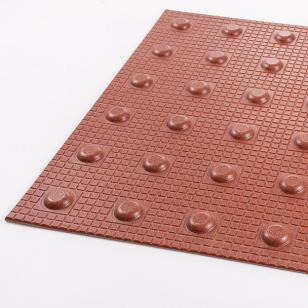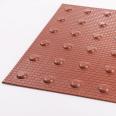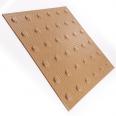Home > Products > Tactile Paving > Surface Mounted Tactile Paving Blister Pedestrian Crossing
TACTILE PAVING: SURFACE MOUNTED TACTILE PAVING BLISTER PEDESTRIAN CROSSING
INFO or ORDER? We’re ready to help:
T: 01757 212744 | E: info@evergrip.com
Product Overview
Product name:
Blister Pedestrian Crossing
Manufactured from:
Stone and resin composite
Sizes available:
- 400mm x 400mm
- 450mm x 450mm
Colour range:
Standard: Buff or Red
Applications, environments
and traffic:
- Cue for visually impaired persons
warning of a controlled or
uncontrolled crossing point where
footway meets carriageway - Internal / external environments
- Pedestrian
Can be fixed to:
Asphalt, concrete, steel, wood &
tiled surfaces
Fixing Method:
Choice of dedicated adhesives
Benefits of Blister Pedestrian Crossing include:
- Rapid installation - reduced labour costs & disruption
- No excavation required - no landfill expense
- Tiles are light in weight and are easy to handle and cut - no hot works
- No requirement for plant machinery and associated access issues/expense
- Durable - harder wearing than concrete
- Will not crack like concrete - prevents future trip hazards. Tile & adhesive permanently flexible
- High slip resistance in dry or wet conditions
- Extensive range of types and colours
- UV tested - no colour fade
- Freeze/thaw tested
- Fast curing colour matched adhesive - surfaces ready to use within 2 hours
- Can be installed even in damp conditions.
- Adheres to all standard surfaces
- Quality assured - manufactured to BS EN ISO 9001-2008
Colours available:
Red
Buff
Types:
Polyurethane
Sizes:
400mm x 400mm
450mm x 450mm
Quantity:
Available in boxes of 10
Applications for Blister Pedestrian Crossing include:
- Pedestrian Crossings: controlled and uncontrolled
- Bus stops
- Traffic islands
- Car parks
- Kerbs and steps
- Changes of direction
DfT Guidance on areas of use: the blister tactile surface should be installed in the absence of an upstand at both controlled and uncontrolled crossing points: where the footway has been dropped flush with the carriageway; or where the carriageway has been raised to the level of the footway.
Red tiles are used for controlled crossings & buff for uncontrolled crossings.
Provides a warning to visually impaired people who would otherwise find it difficult to differentiate between where the footway ends and the carriageway begins.
The blister surface provides a warning to visually impaired people who would otherwise, in the absence of a kerb upstand less than 25mm high, find it difficult to differentiate between where the footway ends and the carriageway begins. The surface is therefore an essential safety feature for this group of road users at pedestrian crossing points, where the footway is flush with the carriageway to enable wheelchair users to cross unimpeded.
The tiles are made from a hard wearing stone and resin composite moulded to create paving which will outperform equivalent concrete product. Tests conducted at the Transport Research Laboratory on product conditioned at 40oC found no measurable loss in height at the end of a scuffing test.
Surface skid resistance measured: 61
Preferred range set by the Joint Mobility Unit of SRV = 50-70
The UK Slip Resistance Group guide to a floor for able-bodied pedestrians.
| SKID RESISTANCE VALUE | POTENTIAL FOR SLIP |
| Above 65 | Extremely Low |
| 35 to 65 | Low |
| 25 to 35 | Moderate |
| 25 and below | High |
Building Investigation and Testing Services (Redhill) conducted a comparative wear test against a concrete blister slab and found the tactile paving had a wear resistance 7 times greater than the equivalent concrete product.
Installation of the tactile surface system is both rapid & straightforward and is achieved using a colour matched, two part adhesive. No excavation is ever required. Small surface irregularities can be covered with the adhesive to
ensure no cavities are left beneath the tiles. The tiles can be easily cut to follow kerb lines or to accommodate ramps and drain covers. They naturally deform over cambered, curved areas.
For example, a typical installation to both sides of a controlled pedestrian crossing can be completed in less than 2 hours, reducing disruption to the public. Large areas e.g. railway platforms, can be achieved in overnight/possession times. The tactile surface system can be laid on concrete, tarmac and steel surfaces using either standard urethane adhesive or the moisture tolerant epoxy system.










Share this page
Terms & Conditions | Privacy Policy